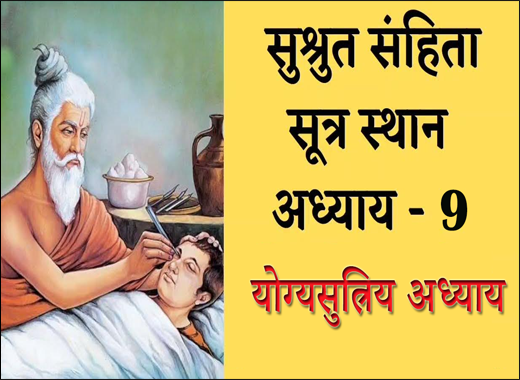Yogyasutriya Adhyaya – 9th Chapter of Sushruta Samhita
Abstract
Acharya Sushruta known as “The Father of Surgery” has written Sushruta Samhita. He has mentioned various medicines and surgeries in this treatise. Sushruta Samhita is one of the oldest books on surgery. It is divided into 5 sthanas (books) which are Sutra sthana, Nidana sthana, Sharira sthana, Chikitsa sthana, Kalpa sthana and Uttar Tantra. In this article, we will discuss Yogyasutriya Adhyaya which is the ninth chapter of Sushruta Samhita (Sutra sthana).

Introduction
In this chapter, Yogyasutriya we will discuss various methods that can be used in practice before initiating your journey as a surgeon. Various plant-based and animal-based materials can be used to practice various surgical procedures like chedan, bhedan, lekhan and vedhan, etc. We will also learn why theoretical study without practicing skills is nothing. One should practice along with studies in order to have complete knowledge of the subject.
Karmabhayasa Mahatva (Importance Of Practice)
The students who have completed the study should also practice. He should be demonstrated various procedures like Snehan (oleation), Swedan (fumigation), Vaman (emesis), Virechan (purgation), Chedan (excision), Bhedan (incision) and Vedhan (puncturing). If a student has already studied all the shastras and hasn’t practised then he is considered unfit for doing surgical procedures.
Karmabhyasa (Practical Training)
Various types of surgical procedures should be used depending upon:-
- Chedana (Excision) – Different types of procedures should be practiced using Pushpa phala (winter melon), Alabu (gourd), Kalindaka (watermelon), Trapusa (cucumber), and Ervaruka (Indian cucumber). Utkartana (upward excision) and Parikartana (downward excision) should also be practiced on the same materials.
- Bhedana (Splitting) – Bhedana karma should be practiced on masak (bellows), and basti (urinary bladder of animals) filled with water and mud.
- Lekhana (Scraping) – Lekhana Karma should be practiced on a broad sheet of hairy leather.
- Vedhana (Puncturing) – Puncturing should be practiced on the veins of dead animals and stalks of lily plants.
- Eshana (Probing) – Probing should be practiced on holes in wood eaten by moths, bamboo, nala and dry alabu.
- Aharana (Extracting) – Extraction should be practiced on the fleshy portion of jack fruit, stone apple fruit and teeth of dead animals.
- Visravana (Draining Fluids) – Visravana karma should be demonstrated on salmali wood coated with beeswax.
- Seevana (Suturing) – Suturing should be practiced by joining the margins of thin and thick cloth or soft leather.
- Bandhana (Bandaging) – Bandhan Karma should be done on dummies made up of cloth and mud.
- Agnikarma (Cauterization) and Ksharakarma (Alkali Cautery) – It should be practiced on soft muscle fragments.
- Karnasandhibandhana – Karnasandhi Bandhan should be practiced on soft fat, muscles and stalk of the lotus plant.
- Vasti Karma (Enema) – Vasti Karma should be practiced on a mud pot filled with water having an orifice and in the mouth of the alabu.
Conclusion
With this we ended Yogyasutriya Adhyaya. We get to know various methods that can be used in practice before doing a particular surgery. After reading this chapter we can conclude that one must have practical skills along with theoretical knowledge. Winter melon, gourd, watermelon, cucumber, jackfruit, stone apple fruit and veins of dead animals are some of the animal-based and plant-based materials on which surgical procedures like incision, excision, scraping and puncturing can be done.



